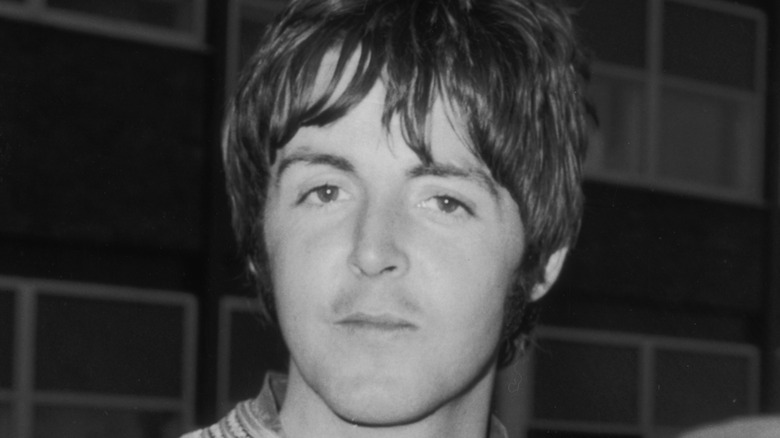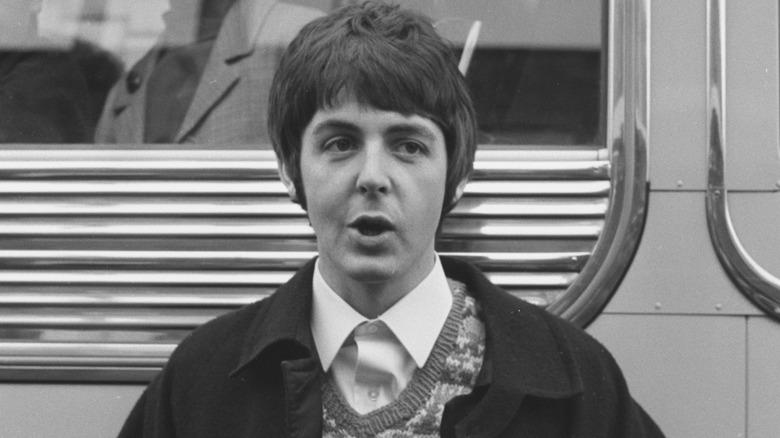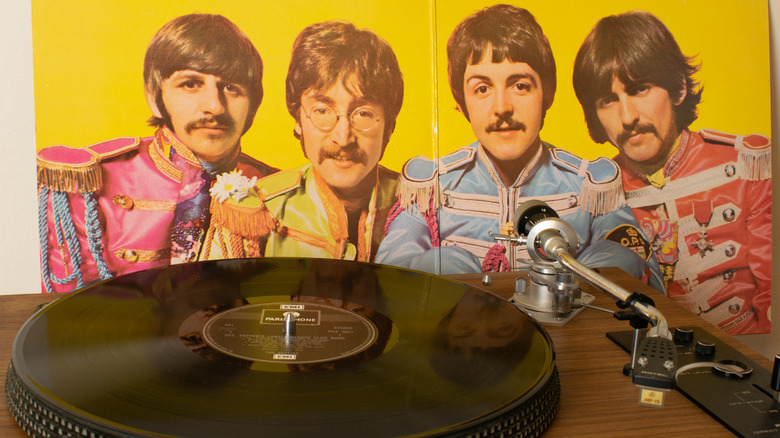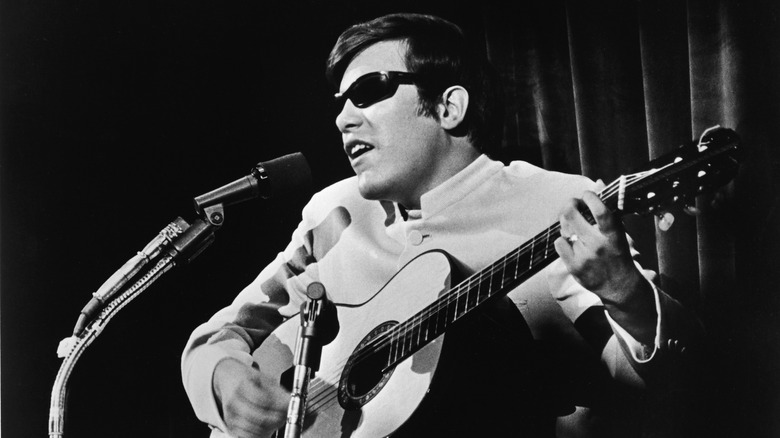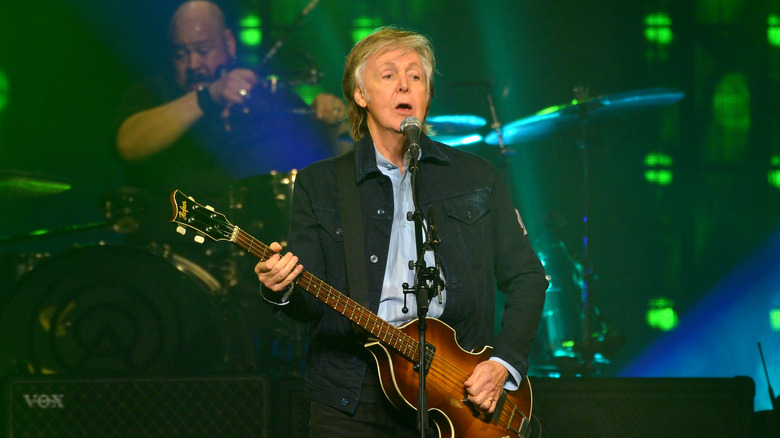The Reason Some Are Convinced Paul McCartney Is A Clone
Conspiracy theories abound everywhere, including the world of popular music. Among the more notorious theories in this category are those that claim a beloved performer is a clone of the original artist who stepped in their place after said artist passed away. And the granddaddy of them all concerns one Paul McCartney, known to one and all as John Lennon's songwriting partner in the Beatles and lead vocalist on many of their greatest hits. Or is that William Campbell?
For those who aren't familiar with the theory, it has long been claimed that McCartney was killed in a car crash in late 1966, forcing the Beatles to cover up the death and hire a replacement who looked and sounded just like him. This clone played with the Fab Four until their 1970 breakup, married Linda Eastman and had three children with her, formed a new band called Wings that was pretty successful in its own right, got married twice more after Linda's death in 1998, and keeps making music up to this day as he approaches his 80th birthday (or the "real" Paul's 80th birthday). We know that's a bunch of hooey because all those milestones we rattled off were accomplished by Paul McCartney himself and not some doppelganger. But why do some people still insist that McCartney is a clone?
William Campbell: Meet the purported McCartney clone
According to the official website of London suburb St. Margarets, the man who allegedly became Macca was born William Campbell Shears in Shreveport, Louisiana, on September 16, 1940. However, the purported clone's birth name and birthplace may vary depending on the source; some sources claim he was a Canadian man named William Shears Campbell. Everything after that is pretty much similar — this guy supposedly won a Beatles lookalike contest organized in secret by manager Brian Epstein as a contingency plan in case one of the Fab Four died. And when McCartney was allegedly killed in a car crash on November 9, 1966, the Paul lookalike, who commonly went by the name Billy Shears, was dispatched to assume the singer-bassist's identity. He then quickly learned how to speak like a native Liverpudlian despite being from North America.
Picking up a regional British accent was one thing, but what about the process of making this Billy Shears fellow look like a true Paul McCartney doppelganger? St. Margarets notes that all he needed was a little plastic surgery. And to further make it appear as if McCartney didn't die in an automobile accident, this ersatz Macca eventually grew out his facial hair, with his Beatles bandmates following suit to keep the ruse going. (As the story goes.)
In the comments section of St. Margarets' article, multiple users called cow dung on those theories, with one pointing out that plastic surgery was far from being advanced enough to make Campbell/Shears look almost exactly like McCartney. Another wrote that the scar from McCartney's upper lip actually came from a moped accident he had in December 1965 — a fact that's separately documented by reliable sources such as Beatles Bible.
So many clues in the Beatles' discography
The alleged clues pointing to Paul McCartney being a clone from November 9, 1966, onward are plentiful enough to fill an entire article. But we'll stick to the basics here, starting with the presence of "Billy Shears" in the Beatles' 1967 album "Sgt. Pepper's Lonely Hearts Club Band." Yes, it's Ringo Starr singing lead vocals on "With A Little Help From My Friends" right after being introduced as Billy Shears, but it was from that album onward that the clues kept piling up.
This culminated with the album cover of 1969's "Abbey Road," where all four Beatles were dressed up as people in a funeral, including the shoeless McCartney as the person being buried. But aside from McCartney confirming he went barefoot because the photoshoot took place on a hot day, other clues on the "Abbey Road" cover don't add up. That "28IF" license plate, pointing to Macca's age had he been alive at the time of the shoot? You do the math — James Paul McCartney was born on June 18, 1942. The photoshoot happened on August 8, 1969.
But who's to blame for the "Paul is dead" theory truly blowing up? Most sources name two Michigan men — disc jockey Russ Gibb, who entertained a caller asking about the rumors for one whole hour on October 12, 1969, and University of Michigan student Fred LaBour, who, two days later, co-wrote an article on McCartney's "death" based on several alleged Easter eggs hidden in recent Beatles songs and albums, all of which he had made up (via Michigan Today). Unfortunately, the satire was lost on many of those who read the story and took it as the gospel truth.
Even famous singers seemed to cash in on the 'Paul is dead' rumors
As explained by Rolling Stone, the flood of unsubstantiated "Paul is dead" reports led to bands cashing in and releasing songs about the rumors. These included "Brother Paul" by Billy Shears & the All-Americans and "We're All Paul Bearers" by Zacherias and the Tree People — catchy tunes, but, um, just who are those guys?
While you may not have heard of either of the groups mentioned above, there's a chance you're at least vaguely familiar with the man behind the Werbley Finster pseudonym — Puerto Rican singer-guitarist Jose Feliciano (pictured), who is best known for his soft-rock cover of the Doors' "Light My Fire" as well as the Christmas classic "Feliz Navidad." His 1969 single "So Long Paul" directly references the rumors of Paul McCartney's death, and while it may have fooled some people, it's obviously a jaunty novelty that assures listeners from the second verse onward that McCartney is alive and well.
That same year, Terry Knight, who later gained more fame behind the scenes as Grand Funk Railroad's manager and producer, recorded a song, "Saint Paul," that, according to Plastic Macca, seemed to imply that McCartney died and was replaced by a clone. Knight, who was murdered in 2004, notably refused to talk about the tune in the years that followed. Perhaps because it sounded way too close to "Hey Jude" for comfort?
The McCartney clone theories continue to this day
Despite all the times the rumors and "death clues" have been debunked, despite all the times sensible Beatles fans insisted that John Lennon was saying "cranberry sauce" (and not "I buried Paul") at the end of "Strawberry Fields Forever," and despite all the incontrovertible evidence that Paul McCartney is still alive, new theories have kept popping up, pushing the ludicrous narrative that Macca was replaced by some dude named William.
For one, Tina Foster, author of the book "Plastic Macca: The Secret Death and Replacement of Beatle Paul McCartney" runs a personal blog site, one that has since shifted its focus toward other unfounded conspiracy theories but still touches occasionally on purported McCartney death/replacement clues. YouTube is still packed with videos showcasing the hidden messages revealed when certain Beatles songs (or their solo recordings) are played backward, and these include some newer tunes, such as McCartney's 2007 song "Gratitude," where he reportedly sings "I was Willy Campbell" in its backward-masked form.
While all these efforts to prove that the Paul McCartney we know is actually a clone will likely continue in some form or fashion despite all the evidence to the contrary, we can all go back to former Beatles manager Allen Klein's wisecrack about the whole "I buried Paul" brouhaha, as quoted by Rolling Stone: "On that particular take, [John Lennon's] guitar buried Paul's sound."
Indeed, it did.
